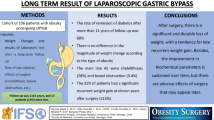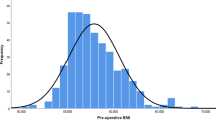Abstract
Background
Dyslipidemia is a known risk factor for cardiovascular (CV) events. The aim of the study was to assess lipid profiles and their impact on CV risk changes in a large patient cohort 5 years after Roux-en-Y gastric bypass (RYGB).
Methods
All patients who underwent primary RYGB for severe obesity in our two hospitals between January 1999 and December 2009 were included. The Framingham risk score was used.
Results
One thousand and forty-eight patients were included, 791 women and 257 men. Five-year complete lipid profile was available for 77% of patients. At 5 years, mean body mass index (BMI) decreased from 45.7 ± 6 to 31 ± 5.8 kg/m2 (p < 0.001), excess BMI loss (EBMIL) was 72.35 ± 22%, and total body weight loss (TWL) 31.5 ± 9%. Lipid values improved significantly. Total- and LDL-cholesterol levels dropped at 1 year from 5.4 to 4.48 mmol/L and 3.2 to 2.41 mmol/L, respectively, and slightly increased thereafter. Triglyceride levels dropped from 2 to 1.17 mmol/L at 1 year and remained unchanged. HDL levels rose continuously from 1.27 to 1.77 mmol/L at 5 years. Lipid profile improved more in patients with greater weight loss (%EBMIL ≥ 50 or %TWL ≥ 25%). Assuming that all patients were non-smokers and other baseline risk factors (hypertension, diabetes) remained unchanged at 5 years, the amelioration of the lipid profile itself yielded to a 27% reduction of CV risk (p < 0.001).
Conclusions
RYGB results in sustained excess weight loss and in amelioration of the lipid profile from the first to fifth postoperative year. This improvement translates into significantly lower CV risk from the first year after surgery.





Similar content being viewed by others
References
Lopez AD, Mathers CD. Measuring the global burden of disease and epidemiological transitions: 2002-2030. Ann Trop Med Parasitol. 2006;100:481–99.
Miniño AM. Death in the United States, 2011. NCHS Data Brief. 2013;115:1–8.
Gupta S, Gudapati R, Gaurav K, et al. Emerging risk factors for cardiovascular diseases: Indian context. Indian J Endocrinol Metab. 2013;17:806–14.
Appachi S, Kelly KR, Schauer PR, et al. Reduced cardiovascular risk following bariatric surgeries is related to a partial recovery from “adiposopathy”. Obes Surg. 2011;21:1928–36.
Mingrone G, Panunzi S, De Gaetano A, et al. Bariatric–metabolic surgery versus conventional medical treatment in obese patients with type 2 diabetes: 5 year follow-up of an open-label, single-centre, randomized controlled trial. Lancet. 2015;386:964–73.
Wilson PWF, D’Agostino RB, Levy D, et al. Prediction of coronary heart disease using risk factor categories. Circulation. 1998;97:1837–47.
Bannister CA, Poole CD, Jenkins-Jones S, et al. External validation of the UKPDS risk engine in incident type 2 diabetes: a need for new type 2diabetes-specific risk equations. Diabetes Care. 2014 Feb;37(2):537–45.
Graversen P, Abildstrøm SZ, Jespersen L, et al. Cardiovascular risk prediction: can Systematic Coronary Risk valuation (SCORE) be improved by adding simple risk markers? Results from the Copenhagen City Heart Study. Eur J Prev Cardiol. 2016;23:1546–56.
Mor A, Omotosho P, Torquati A. Cardiovascular risk in obese diabetic patients is significantly reduced one year after gastric bypass compared to one year of diabetes support and education. Surg Endosc. 2014;28:2815–20.
Heffron SP, Parikh A, Volodarskiy A, et al. Changes in lipid profile of obese patients following contemporary bariatric surgery: a meta-analysis. Am J Med. 2016;129:952–9.
Goday A, Benaiges D, Parri A, et al. Can bariatric surgery improve cardiovascular risk factors in the metabolically healthy but morbidly obese patient? Surg Obes Relat Dis. 2014;10:871–6.
Faria G, Pestana D, Aral M, et al. Metabolic score: insights on the development and prediction of remission of metabolic syndrome after gastric bypass. Ann Surg. 2014;260:279–86.
Donadelli SP, Salgado Jr W, Marchini JS, et al. Change in predicted 10-year cardiovascular risk following Roux-en-Y gastric bypass surgery: who benefits? Obes Surg. 2011;21:569–73.
Kligman MD, Dexter DJ, Omer S, et al. Shrinking cardiovascular risk through bariatric surgery: application of Framingham risk score in gastric bypass. Surgery. 2008;143:533–8.
Vogel JA, Franklin BA, Zalesin KC, et al. Reduction in predicted coronary heart disease risk after substantial weight reduction after bariatric surgery. Am J Cardiol. 2007;99:222–6.
Torquati A, Wright K, Melvin W, et al. Effect of gastric bypass operation on Framingham and actual risk of cardiovascular events in class II to III obesity. J Am Coll Surg. 2007;204:776–82.
Aftab H, Risstad H, Søvik TT, et al. Five-year outcome after gastric bypass for morbid obesity in a Norwegian cohort. Surg Obes Relat Dis. 2014;10:71–8.
Batsis JA, Sarr MG, Colazzo-Clavell ML, et al. Cardiovascular risk after bariatric surgery for obesity. Am J Cardiol. 2008;102:930–7.
Aminian A, Daigle CR, Romero-Talamás H, et al. Risk prediction of complications of metabolic syndrome before and 6 years after gastric bypass. Surg Obes Relat Dis. 2014;10:576–82.
Jamal M, Wegner R, Heitshusen D, et al. Resolution of hyperlipidemia follows surgical weight loss in patients undergoing Roux-en-Y gastric bypass surgery: a 6-year analysis of data. Surg Obes Relat Dis. 2011;7:473–9.
Carswell KA, Belgaumkar AP, Amiel SA, et al. A systematic review and meta-analysis of the effects of gastric bypass on plasma lipid levels. Obes Surg. 2016;26:843–55.
von Elm E, Altman DG, Egger M, et al. STROBE initiative. The Strengthening the Reporting of Observational Studies in Epidemiology (STROBE) statement: guidelines for reporting observational studies. Int J Surg. 2014;12:1495–9.
National Institutes of Health. Third Report of the National Cholesterol Education Program (NCEP) Expert Panel on Detection, Evaluation, and Treatment of High Blood Cholesterol in Adults (Adult Treatment Panel III) NIH Publication No. 01–3670 May 2001 https://www.nhlbi.nih.gov/guidelines/cholesterol/atp3xsum.pdf
Kones R. Primary prevention of coronary heart disease: integration of new data, evolving views, revised goals, and role of rosuvastatin in management. A comprehensive survey. Drug Des Devel Ther. 2011;5:325–80.
Shay CM, Gooding HS, Murillo R, et al. Understanding and improving cardiovascular health: an update on the American Heart Association’s Concept of Cardiovascular Health. Prog Cardiovasc Dis. 2015;58(1):41–9.
Dallal RM, Hatalski A, Trang A, et al. Longitudinal analysis of cardiovascular parameters after gastric bypass surgery. Surg Obes Relat Dis. 2012;8(6):703–9.
Cunha FM, Oliveira J, Preto J, et al. The effect of bariatric surgery type on lipid profile: an age, sex, body mass index and excess weight loss matched study. Obes Surg. 2016;26(5):1041–7.
Adams TD, Mehta TS, Davidson LE, et al. All-cause and cause-specific mortality associated with bariatric surgery: a review. Curr Atheroscler Rep. 2015;17(12):74.
Griffo E, Cotugno M, Nosso G, et al. Effects of sleeve gastrectomy and gastric bypass on postprandial lipid profile in obese type 2 diabetic patients: a 2-year follow-up. Obes Surg. 2016;26:1247–53.
Adams TD, Gress RE, Smith SC, et al. Long-term mortality after gastric bypass surgery. N Engl J Med. 2007;357:753–61.
Pihlajamäki J, Grönlund S, Simonen M, et al. Cholesterol absorption decreases after Roux-en-Y gastric bypass but not after gastric banding. Metabolism. 2010;59:866–3.
Carswell KA, Vincent RP, Belgaumkar AP, et al. The effect of bariatric surgery on intestinal absorption and transit time. Obes Surg. 2014;24:796–805.
Aminian A, Zelisko A, Kirwan JP, et al. Exploring the impact of bariatric surgery on high density lipoprotein. Surg Obes Relat Dis. 2015;11:238.
Ties JS, Zlabek JA, Kallies KJ, et al. The effect of laparoscopic gastric bypass on dyslipidemia in severely obese patients: a 5-year follow-up analysis. Obes Surg. 2014;24:549–53.
Soran H, Schofield JD, Adam S, et al. Diabetic dyslipidaemia. Curr Opin Lipidol. 2016;27:313–22.
Fletcher B, Berra K, Ades P, et al. American Heart Association scientific statement managing abnormal blood lipids: a collaborative approach. Circulation. 2005;112:3184–209.
Millán J, Pintó X, Muñoz A, et al. Lipoprotein ratios: physiological significance and clinical usefulness in cardiovascularprevention. Vasc Health Risk Manag. 2009;5:757–65.
Hendrani AD, Adesiyun T, Quispe R, et al. Dyslipidemia management in primary prevention of cardiovascular disease: current guidelines and strategies. World J Cardiol. 2016;8:201–10.
Christou NV. Impact of obesity and bariatric surgery on survival. World J Surg. 2009;33:2022–7.
Sjöström L. Bariatric surgery and reduction in morbidity and mortality: experience from the SOS study. Int J Obes. 2008;32(Suppl 7):S93–7.
Mehaffey JH, LaPar DJ, Clement KC, et al. 10-Year outcomes after Roux-en-Y gastric bypass. Ann Surg. 2016;264:121–6.
Schauer PR, Bhatt DL, Kirwan JP, et al. STAMPEDE Investigators. Bariatric surgery versus intensive medical therapy for diabetes—3-year outcomes. N Engl J Med. 2014;370:2002–13.
Maniscalco M, Carratù P, Faraone S, et al. Smoking habit in severe obese after bariatric procedures. Tob Induc Dis. 2015;13:20.
Cena H, De Giuseppe R, Biino G, et al. Evaluation of eating habits and lifestyle in patients with obesity before and after bariatric surgery: a single Italian center experience. Springerplus. 2016;5:1467.
Gero D, Dib F, Ribeiro-Parenti L, et al. Desire for core tastes decreases after Sleeve gastrectomy: a single-center longitudinal observational study with 6-month follow-up. Obes Surg. 2017; https://doi.org/10.1007/s11695-017-2718-2.
Funding
There are no funding sources involved.
Author information
Authors and Affiliations
Corresponding author
Ethics declarations
Conflict of Interest
The authors declare that they have no conflict of interest.
Informed Consent
Informed consent was obtained from all patients before surgery, which included consent for the procedure as well as for follow-up, inclusion in our database, and de-identified outcome data reporting.
Ethical Approval
All procedures performed in this study were in accordance with the ethical standards of the institutional research committee and with the 1964 Helsinki declaration and its later amendments. The study was approved by the institutional review board (decision 304/15).
Additional information
This study was presented as oral communication at the 7th Congress of the International Federation for the Surgery of Obesity and Metabolic Disorders European Chapter (IFSO-EC), 1–4 June 2016, Gothenburg, Sweden.
Rights and permissions
About this article
Cite this article
Gero, D., Favre, L., Allemann, P. et al. Laparoscopic Roux-En-Y Gastric Bypass Improves Lipid Profile and Decreases Cardiovascular Risk: a 5-Year Longitudinal Cohort Study of 1048 Patients. OBES SURG 28, 805–811 (2018). https://doi.org/10.1007/s11695-017-2938-5
Published:
Issue Date:
DOI: https://doi.org/10.1007/s11695-017-2938-5




